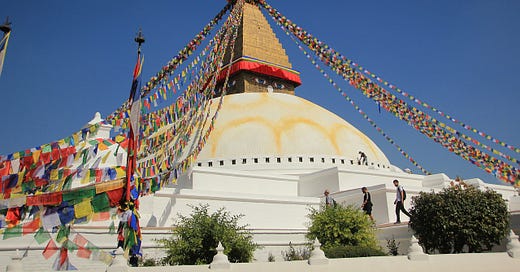Hi everyone
Greetings from Bright Earth Buddhist Temple, this weekend we had a work morning in the garden, tidying some of the rougher edges and making sure the meditation paths are clear to walk around. Our meditation classes continue to grow, and I continue to love the ritual and chanting in our public practice sessions (join us in person or via Zoom). Last night some of us watched Spain beat England in the Euro finals. Dukkha!
This week in the newsletter, a teaching on the elements practice.
I remember Dad coming through the door smelling of engine oil, grease, sweat and exhaust fumes. I remember the rough texture of his overalls. I remember the pink soap that was like gel with little hard bits in it to really get all the grime off his hands.
Right now I have coffee brewing in a stainless steel cafetiere here on my desk. Soon I will drink the coffee and then I will smell like coffee. I will taste like coffee.
Last night, after dinner, my fingers smelled like onions and garlic.
Are any of these things we carry a part of us? Where do we begin and end? Where does the world begin and end?
My Dad smelled of his work, and he smelled of himself and when I was a little child those were the same things.
We are made of the world.
Why is the hair on my head a part of me, and not the hair on the barbershop floor?
I think I am my body, but there are as many cells of bacteria in here as are there “human” cells.
We are made of the world and we are constantly being remade. Taking some things in. Giving some things out. Never fixed. Never still.
When new monks and nuns first joined the Buddha he would often ask them to practice mindfulness of the elements as their first meditation practice. He instructed them to notice the earth element in their own bodies, and to notice how that was the same as the earth element in the world. To do the same with water, fire and air.
Or as Terry Pratchett put it in the nursery rhyme he made up for his novel Wintersmith:
“What makes a man?
Iron enough to make a nail,
Lime enough to paint a wall,
Water enough to drown a dog,
Sulphur enough to stop the fleas…”
You might read this newsletter and go, “Oh yeah, I know this. I’ve heard this before.” I know that I do that sometimes. I dismiss something because I think that I already learnt it.
When I was a kid I learnt that human beings were “ugly bags of mostly water” (as the crystalline aliens describe humans in the Star Trek: The Next Generation episode Homesoil). I’ve known that for a long time! But do I live as if these things are true? No. So I keep coming back to these teachings and practices.
The Buddha wanted his monks and nuns to really understand this. It’s why he asked them to meditate in this way, and not to just listen to him talking about it. He wanted them to spend time on this, until they knew it with their whole being. He wanted them to stay curious and to ask “If this is true, what does it mean?”
What does it mean to have a body that is made of the same stuff as the universe? What does it mean to have a body that grows and changes over time? How does it feel to have a body that is not fixed, in a universe that is not fixed?
The Buddha knew that these questions could open the gates of enlightenment.
Namo Amida Bu
Kaspa
For Buddhist newsletters from other traditions, check out Dharmastack, collated by Maia Duerr.






